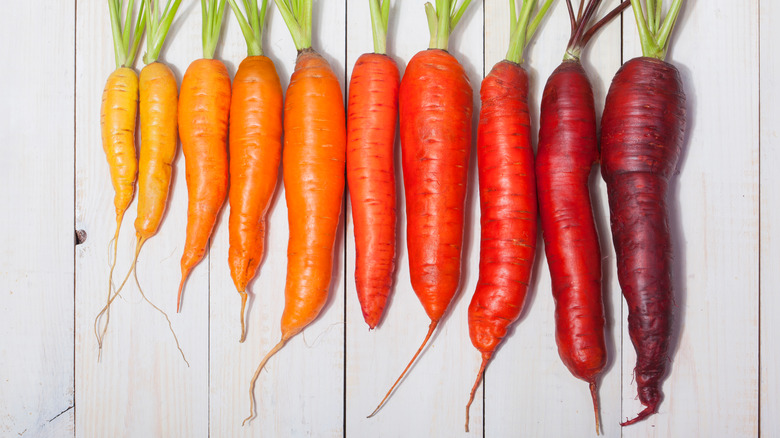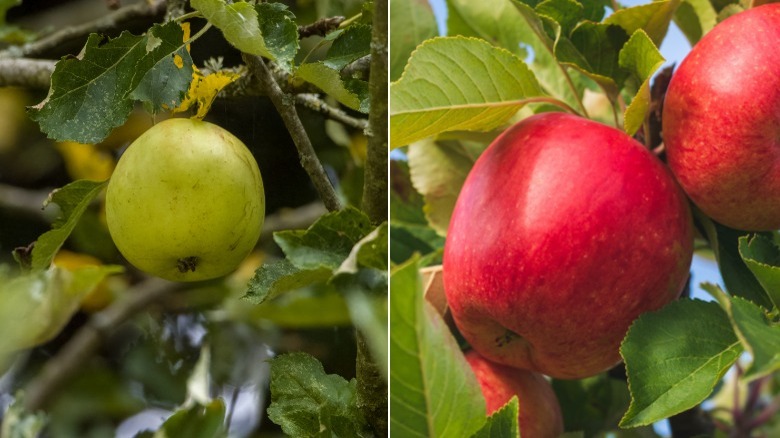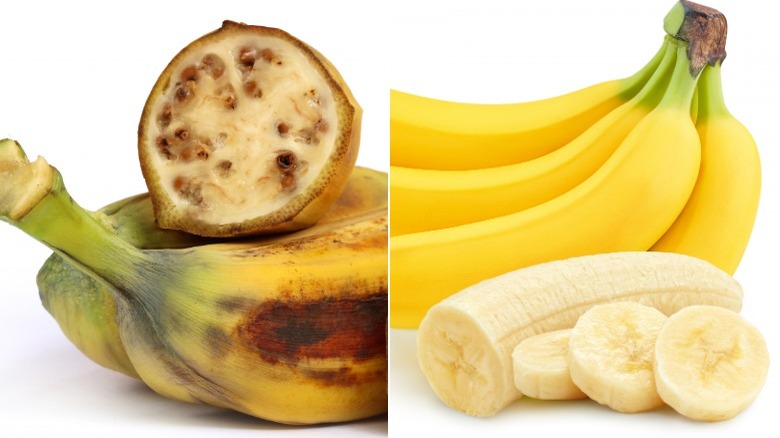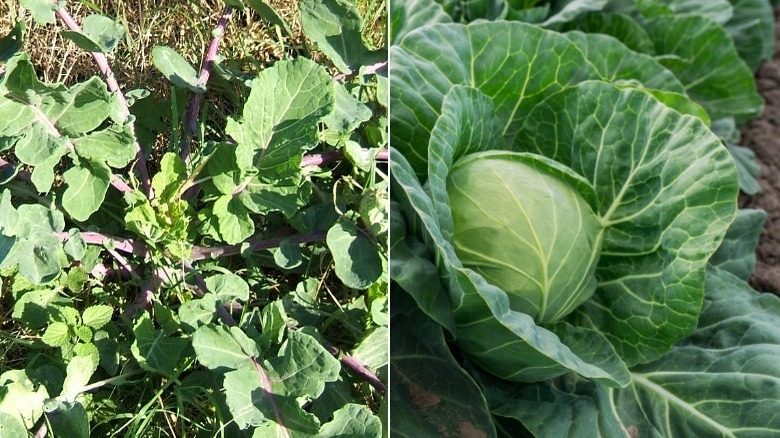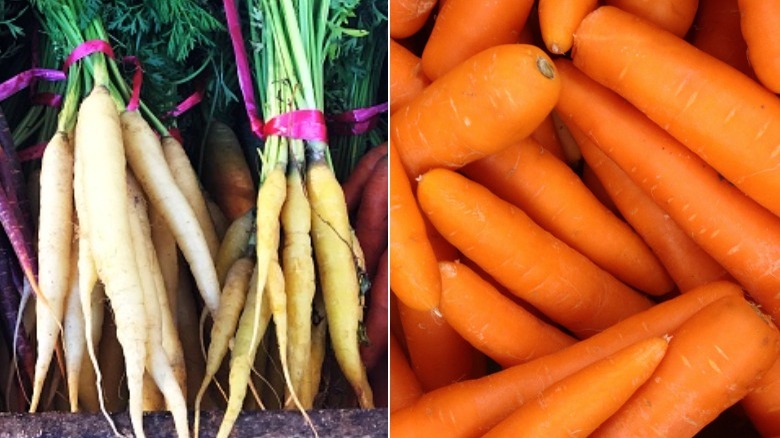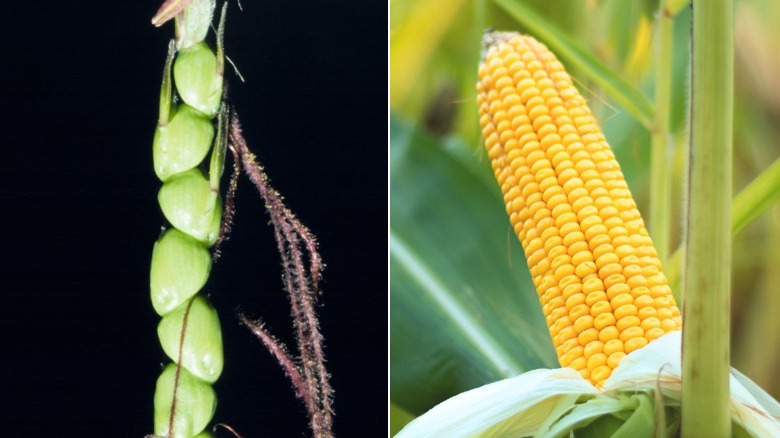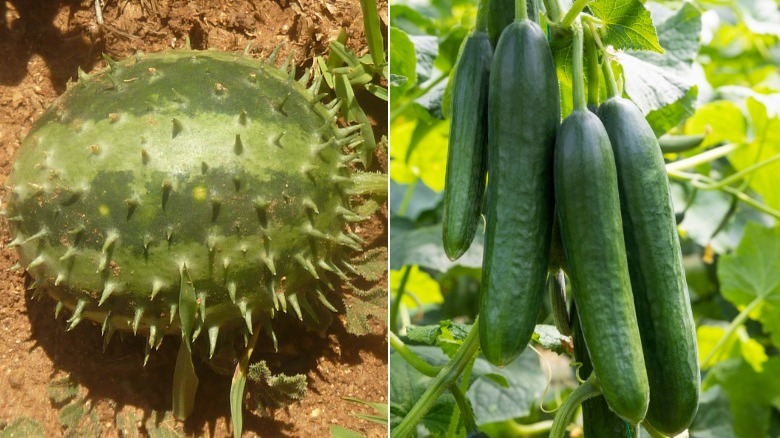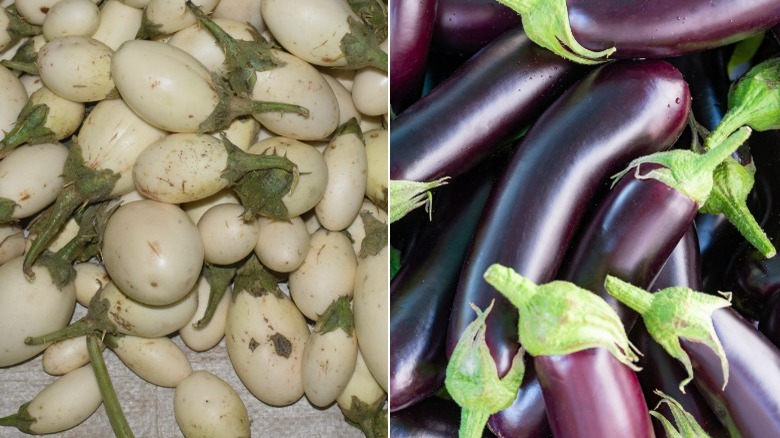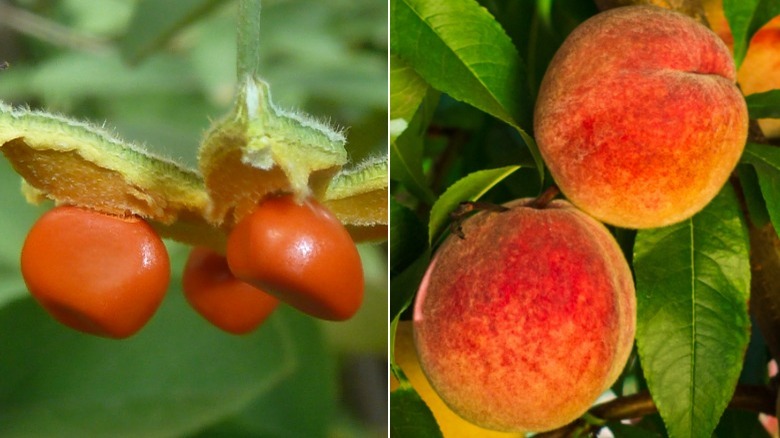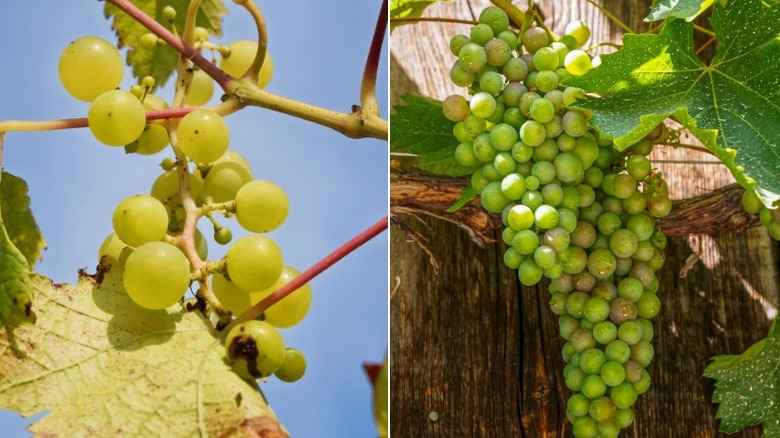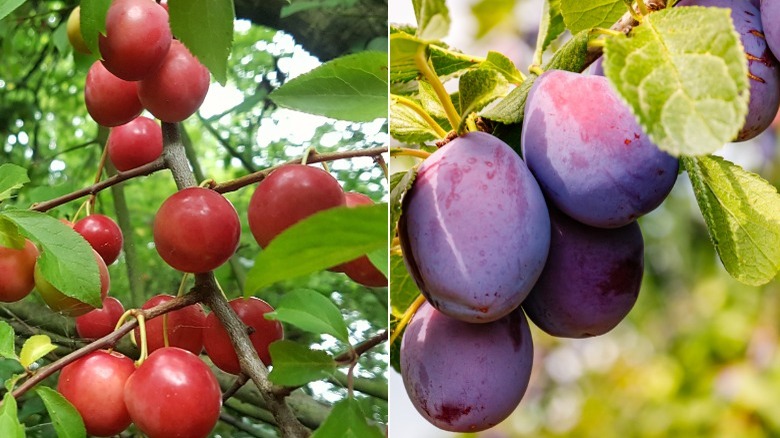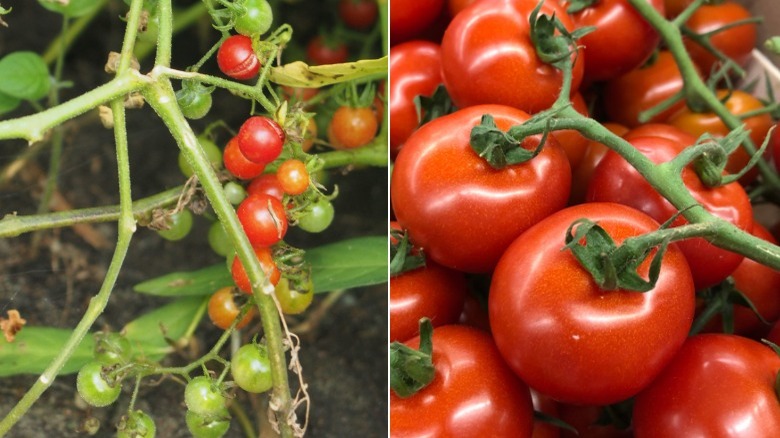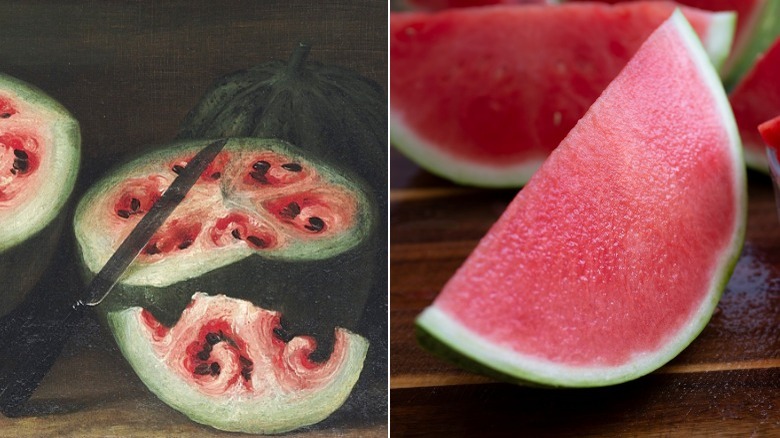12 Vegetables And Fruits That Used To Look Very Different
Long before there were GMO foods and cultivated meat, human beings were genetically engineering what we ate. As soon as we abandoned the hunter-gather lifestyle for farming, people began cultivating specific varieties of fruits and vegetables to select for more desirable traits. This was important at the dawn of the agricultural revolution because ancient fruits and vegetables had tougher skin, bitter flesh, and cartoonishly large seeds. For humans to get the most nutrition out of the food we planted, we needed to grow the best of the best. Over time, this selective breeding, also called artificial selection, allowed humans to produce bigger, sweeter, and more appetizing food at higher yields — all without advanced technology.
Thanks to selective breeding, modern fruits and vegetables taste more like dessert than they do healthy food — at least in comparison to their wild, undomesticated cousins. Here are a dozen fruits and veggies that have come a long way over these last 12,000 years. The history behind this bunch of produce is almost as rich as its flavor.
1. Apples
One of the most famous fruits in all of Western history, the apple first originated in central Asia. Along with raspberries, plums, and cherries, apples are actually members of the rose family. By today's taste standards, the wild apple, Malus sieversii, is inedible. Smaller and rounder yet similarly colored to the modern apple, the wild apple can be "sour enough to set a squirrel's teeth on edge and make a jay scream," according to Henry David Thoreau. Most people — Thoreau excepted — prefer the predictable sweetness of orchard-grown fruit.
Apples have a unique botanical characteristic called extreme heterozygosity, meaning they can produce an astonishing array of varieties and can grow in a number of climates. This extraordinary flexibility has a downside: Apples grown from seed may look and taste wildly different from their predecessors. That poses a problem for apple farmers who want to repeatedly cultivate their favorite varieties. The modern apple, Malus domestica, must be grafted in order to ensure this kind of replicability. Farmers do this by inserting a small fruiting plant into the limb of an existing tree, called a rootstock. This process is much faster than growing trees from seed, and it produces trees that are more cold-tolerant and disease- and insect-resistant. That leaves the wild apples for the birds ... and Thoreau.
2. Bananas
Humans have cultivated bananas for around 7,000 years. Back then, people ate the flowers or the tubers of the tree — not its fruit. That's because in the wild, bananas are greener, shorter, stockier, and chock full of hard, large seeds necessary for reproduction. When cultivated by humans, however, bananas don't need seeds, giving the fruit more room for that sweet flesh and making them easier to eat.
The next time you bite carefree through a banana, thank horticulturalist William Cavendish. The bananas we eat today are direct descendants of this British-grown variety first established in the 1830s. After the Cavendish banana arrived in the Canary Islands, it went into large-scale production and never ceased. Today, of the over 1000 varieties of bananas, Cavendish bananas make up more than half of bananas exported to the U.S. and Europe. Cavendish bananas are easy to grow because they are cultivated from genetically identical plants that grow on the roots of a mother plant. This ensures an identical, seedless fruit, harvest after harvest.
For this reason, bananas serve as an excellent example of one of the criticisms of the genetic engineering of food: Monoculture. By relying on any one variety of crop, humans make the food supply vulnerable to disease or changes in weather due to the climate crisis. Bananas are big business — $8 billion a year — and with this fruit facing threats like bacterial wilt and Panama disease, the concern over monoculture is understandable.
3. Cabbage
Cabbage is a European member of the Brassica oleracea family. These easily domesticated cruciferous vegetables are an excellent example of artificial selection. From this one species alone we enjoy a variety of veggies including broccoli, cauliflower, kale, kohlrabi, and Brussels sprouts. In the wild, the leaves of the cabbage are not nearly as tightly packed, but they are still the same species as the domesticated variety.
The Ancient Greeks believed that cabbage grew in the spots where Zeus' sweat dripped down from Mt. Olympus. At the same time in Asia, people dined on Asian members of the Brassica rapa: Turnips, Chinese cabbage, and bok choi. A study published in Nature Genetics in 2016 details an investigation into how these two Brassica varieties developed at the same time in different places around the world. Researchers determined that, for cabbage, it was a case of convergent domestication. This was caused by the fact that large segments of Brassica DNA and genes have three copies in the genome. These triplicates make it easier to create more diversity of species and explain why Brassica varieties appeared simultaneously on two continents. A 2021 study in the Oxford Journal of Molecular Biology and Evolution acknowledged the importance of studying a genus as versatile as Brassica to understand how other foods may be able to adapt to climate change.
4. Carrots
Carrots now come in a rainbow of hues ranging from pale white to deep purple. The less colorful variety share that quality in common with wild carrots, which are mostly light yellow and white. After carrots were domesticated 5,000 years ago, they became brighter yellow and purple, splitting off into two main classes — the Asiatic group and the Western group. The carrots then mutated naturally to orange, and farmers in the West have selectively cultivated them for that color as far back as the 14th century.
Or at least that's the story science tells. Others argue that the orange veggies we love are a result of 17th-century politics. In Dutch mythology, the orange carrot earned its esteemed place in global cuisine thanks to farmers who cultivated them to honor William of Orange, the founder of the Netherlands. From there, the story goes, orange carrots took off the world around, and today the orange hue reigns supreme. But experts argue that it's the mild and humid Dutch climate that simply suits orange carrots better than other varieties. Nothing political, just ecology.
5. Corn
Nine thousand years ago, what we know as sugary-sweet and oh-so-juicy corn kernels looked and tasted more like tiny uncooked potatoes. The undomesticated corn cob, called teosinte, was a thousand times smaller than a contemporary cob. To get to the handful of very hard, very small kernels from inside, you'd have to crack open the cob open with a rock. This laborious process makes shucking corn today sound downright simple.
Since the 15th century, when European settlers acquired a taste for this originally Central American food, corn has undergone a massive transformation. It's now available in five colors and around 200 varieties, and it's grown in nearly 70 nations around the world. Corn remains true to its starchy roots, although today it's lightly less juicy. Hundreds of years of artificial selection made corn easy to grow and added three times the sweetness. Today corn is one of the most commonly cultivated crops in the U.S., and, according to the FDA, over 90% of the corn grown today has been genetically modified.
6. Cucumbers
Like cabbage, the domesticated cucumber emerged in both Europe and Asia at the same time, around 11,000 years ago. Cucumbers are one of around 1,000 members of the Cucurbitaceae family, better known as gourds. While other gourds like honey melon, pumpkin, squash, watermelon, and zucchini are all known for their sweetness, wild cucumbers are sour and bitter. From the beginning, humans have selected for fruits with sweeter, less bitter flesh, breeding the wild out of them.
Small and almost oblong, wild cucumbers look like the plump toddler versions of their long, lean domesticated cousins. They contain high levels of cucurbitacins, the bitter compounds that give these fruits their name and act as a natural defense from invading pests and insects. Cucurbitacins can also cause indigestion and belching — two undesirable qualities — so by the mid-20th century, farmers had developed "burpless" varieties. While cucumbers can still suffer from bitterness, domesticated varieties today are sweet and juicy.
Cucumber lovers today follow in the footsteps ... er, tastebuds of the Egyptians, Greeks, and Romans. When the cucumber spread from its native India throughout Europe, even Henry VII's Spanish wife Catherine of Aragon requested them for her ensalatas. Near the turn of the 16th century, cucumbers crossed the Atlantic and arrived in Haiti. Three hundred years later, Colonial Americans were growing eight different varieties. If you buy cucumber today, you can find several burpless options, or you can simply slice off an inch from the stem-end, remove the skin, and enjoy burp-free.
7. Eggplants
The name of this fruit perfectly exemplifies how selective breeding can radically alter the color, taste, and size of a plant. When English speakers first laid eyes on this native Indian vegetable during the British occupation, they named it for what it looked like: An egg-shaped, -sized, and -colored plant. To this day, small, spiny, and bitter eggplant grows wild in India and China. The oblate-oblong purple plants we see in supermarkets today are the result of selective breeding to yield bigger fruits, more nutrition, and reduced bitterness. In the United Kingdom, it's now common to hear people call this fruit by its more descriptive modern name: Aubergine.
Domesticated eggplants today come in a variety of colors, shapes, and sizes. With skin ranging from black to white and to striped, the inner flesh is uniformly sweet, white, and firm. The average eggplant is around six to nine inches long with purple skin, but Japanese varieties are often longer, thinner, and more delicate. You can still find the namesake small white eggplant, but you'll need to look for it in an ornamental variety as it doesn't produce much edible fruit.
8. Peach
If Roald Dahl had written his children's classic "James and the Giant Peach" 7,500 years ago, it would have been called "James and the Cherry-Sized Peach." The story — like the fruit itself — would have been wildly different. Back then, there were only three varieties of peaches, and they only grew in China. These earthy, sweet-and-sour fruits tasted more like lentils and less like the mouthwatering summer treats they are today. In 4000 B.C., the small, waxy peach was around 40% pit and 60% flesh. The equivalent fruit today is only 10% pit, 90% flesh. Peaches today are 4% sweeter, 30% juicer, and 64 times bigger than their wild kin, all thanks to selective breeding. Peaches today also have more potassium, calcium, and zinc than ancient peaches, according to chemistry teacher James Kennedy.
Peaches traveled out of China and into Rome on the Silk Road. Later, the Conquistadors brought them to the New World where Native Americans heartily embraced their delicious flesh. By the turn of the 18th century, peach trees were so abundant in America that one explorer mistook them for a native species. Today around 200 varieties of peaches are cultivated in over a dozen countries around the world.
9. Grape
One of the oldest, most economically valuable, and most extensively cultivated crops in the world, the grape, Vitis vinifera, is one of around 70 domesticated Vitis species. Research from 2017 uncovered some remarkable history: People began domesticating grapes a mind-blowing 22,000 years ago. More surprisingly, humans were managing wild grapes long before this domestication occurred — longer than even experts had previously believed (via UCI School of Biological Sciences).
Over many millennia of artificial selection, grapes have increased in size, both in terms of individual fruits and the size of harvests overall. They've also been bred to be much sweeter; scientists today can see thousands of years of selective breeding in alterations to key genes related to sugar production. Grapes have even transformed into self-pollinating fruit — all crucial qualities in successful domestication.
The consequence of all this genetic engineering, however, is that grapes have become more fragile. Luckily, scientists believe that we can look to wild grapes to find traits that could make modern grapes as resilient as their predecessors.
10. Plums
Plums have been eaten for millennia, dating at least as far back as the Romans. These delicious stone fruits are native to both Europe and North America, and Native Americans have an extensive and deep history with the plum species that grow wild across the United States. Although experts disagree on the exact number, there are around a dozen wild plum species. With thick, bitter skins and tart flesh, wild plums don't taste much like their domesticated antecedents. Cultivated plums are sweeter and bigger, with thinner skin and pits that easily separate from the flesh.
Domesticated plums arrived in North America via Europe and were cultivated for hundreds of years. But growing conditions in the United States were not ideal for these European imports. Orchards struggled with fungal diseases and flower-eating weevils. By the 19th century, American farmers expressed renewed interest in native species because wild North American plums, while affected by the same issues, fared better. Some of these native varieties even rivaled domesticated plums in terms of flavor and juiciness but didn't often appear on market shelves. Today's renewed interest in native foods has turned the spotlight back on wild plums, perhaps just in time to save a species on the brink of gastronomic extinction. Prunus maritima, the New England beach plum, is one of over 200 endangered American foods protected under the International Ark of Taste.
11. Tomatoes
Although genetic engineering is as old as agriculture itself, the first genetically modified food made headlines in 1994. That year, the FDA allowed the sale of the FLAVR SAVR tomato, leading to a pervasive myth that scientists had injected fish genes into our beloved salad fruits. It's fitting that the tomato of all crops would bring the initialism "GMO" into the American vernacular. It is, after all, the most common garden crop in America. On a global scale, some experts think the tomato might just be the most important crop of all.
Tomatoes are nightshades — members of the Solanaceae family, which includes eggplant, peppers, potatoes, tomatillos, and, surprisingly, tobacco. Wild tomatoes began as cherry-sized fruits dotting the landscapes of South America for the past 80,000 years. Today's 16 varieties of wild tomatoes have a bigger stigma – the female part of the flower – that makes it easier for insects or natural conditions to promote cross-pollination. That stands in stark contrast to domesticated tomatoes which come from one species alone: Solanum lycopersicum. Over the past 7,000 years of domestication, humans have bred tomatoes, like grapes, to self-pollinate in order to prevent accidental cross-pollination with related species. And like with grapes, tomato breeders can look to wild species for genes that resist disease to help counteract the fragility that comes with so much artificial selection.
12. Watermelons
Horticulture students might not expect to study fine art. But anyone interested in crop breeding will spend time examining paintings from the Middle Ages and Renaissance because they show what produce was like hundreds of years ago. A famous 17th-century painting by Giovanni Stanchi depicts a small watermelon with white and pink flesh. The watermelon's black seeds are recessed into the flesh, forming a spiral pattern that is separated into six distinct segments.
Stanchi's watermelon doesn't much resemble the fully-fleshed, ruby red, small-seeded (or seedless) varieties that populate grocery stores today. Those qualities all come courtesy of artificial selection. Over time, watermelons gained more lycopene (the compound responsible for their color), got sweeter and bigger, and shed their seeds. The strain of watermelon like the one in Stanchi's painting, which still exists in a similar form today, has the same white flesh, hollowed-out areas, and lower sugar level.
While researchers aren't entirely sure where this fruit originated, humans have been domesticating Citrullus lanatus for at least 4,300 years. King Tut even had watermelon seeds in his tomb. Today, six wild watermelon species exist, all of which are less vulnerable to insects, viruses, and mold than their civilized cousins. Researchers are already looking to wild populations to bring in genes that could prevent rot without interfering with all the hard-won, desirable qualities humans have bred into this favorite summer fruit.
